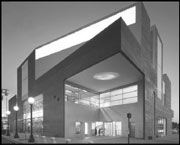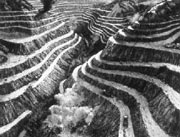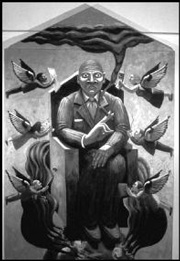More than ever, art museums seem like refuges from serious brainwork. So much of what we see comes in manipulative wrappings—glib voice-overs, insipid soundtracks, and dumbed-down ad campaigns—that to linger quietly in front of artwork (without, thank you, a docent or the headphone tour) can feel thrilling, as if you’ve been suddenly offered the freedom of private response. There’s nothing like the buzz you get from a painting or sculpture that demands a prolonged look and provokes thought.
So it’s disappointing to learn that the Bellevue Art Museum (BAM), after struggling to establish itself in a new home, has apparently decided to steer a course toward the comforts of the familiar, guided by overeager hand-holding. “I think the average attention span is something like 15 seconds for a work of art,” says BAM’s new curator, Ginger Gregg Duggan. “If you just ask people to look at things, there’s no growth there.”
Duggan, who declines to give her age but has been reported elsewhere to be 26, came to Bellevue in April from the Museum of Art in Fort Lauderdale. She says she will be “marketing two major shows every season—something accessible balanced out with something more contemporary or cutting edge. And when it’s not an accessible subject matter or theme, then we’ll try to go with a well-known name or a modern master, like Alex Katz [whose work is currently on view]. . . . It’s something [visitors] still feel comfortable with when they walk in the space.” A list of future exhibitions under Duggan’s direction includes puppets from the Vermont-based Bread and Puppet Theater, light shows by Gary Ewing, and a survey of modern fashion. It’s difficult to tell which of these are supposed to be accessible and which cutting edge.
There’s no doubt that BAM needed to make some kind of programming change. The museum’s new building—a strong, generally art-friendly design by architect Steven Holl—let BAM escape the confines of Bellevue Square (where it had remained relatively hidden for 15 years), but it apparently had a disorienting effect. A visit earlier this summer revealed just how little BAM has taken advantage of the building’s 36,000 square feet. In several obvious places where you’d expect to see art, the walls were bare. Carlos Mollura’s “Inflated Interventions”—air-filled objects pushed into corners (there until Aug. 18)—looked more like beach-toy prototypes rejected by Target. A single sculpture—a lonely Deborah Butterfield horse grazing on cement—stood in an outdoor courtyard on the second floor. Even the cafe seemed undeveloped; price tags still dangled from piecemeal furniture and cushions.
The lack of energy may result from cost-cutting measures taken by new executive director Kathleen Harleman (who was also hired from the Museum of Art in Fort Lauderdale). According to a recent report in the Puget Sound Business Journal, the museum, suffering from low attendance and a recession, is now operating almost a million dollars in the red. BAM’s longtime Northwest Annual, a juried competition that’s endured as a lively and often experimental showcase of local artists, has been canceled this year, and Duggan makes no promises that it will appear again.
BAM appears to have decided that art by itself does not provide sufficient entertainment. Duggan plans to offer “activity packs” that will encourage visitors to interact with what they see.
One of BAM’s current shows—”In Response to Place,” a traveling exhibit of photographs of areas around the world deemed important by the Nature Conservancy—is small and fairly predictable, though not without its pleasures (notably, Annie Leibovitz’s eerie black-and-white views of the Shawangunk Mountains of New York and Hope Sandrow’s gorgeous, nearly abstract color series taken half underwater in Indonesia’s Komodo National Park). Still, the visitor response area, right in the middle, does not appear to offer “growth” in any way; after a couple of weeks, it seemed only irrelevant. Children’s postcard scribbles hung on a wall, and in specimen jars intended for the collection of soil and water from your favorite place, visitors had instead sealed up “wind,” “sunlight,” “breath,” labels for the jars, and a business card.
Does BAM really want to use up valuable space—in a $23 million building— for these sorts of participatory games when it already devotes most of the second floor to a beginner’s art school? BAM might be better off expending its efforts on more effectively displaying the art—particularly on removing the annoying reflections made by the third floor’s excess of natural light.
“If you’re going to choose to show something like ‘Houses by Artists’ [a series of interpretations of the house, scheduled for September],” Duggan explains, “then I have an equal responsibility to program it in a way that people can relate to. It’s not about cool art: ‘Let’s put it up, I don’t care if anyone gets it.'”
Of course, pandering to the average only promotes the average and risks being condescending. Maybe in an age of gloss and simple answers, being dumbfounded by complexities and mystery—or concentrating on an artwork for more than 15 seconds—is exactly what we all need once in a while. Here’s hoping that BAM’s new directors eventually understand there’s comfort in that, too.









